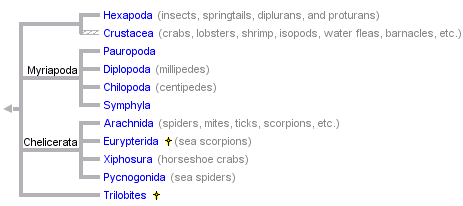
Major arthropod groups

Traditionally placing arthropods into groups was based on tagmata or how segments are divided into functional units. Now we also use molecular relationships. Body of primitive forms is homonomous (all body segments are very similar), but in vast majority there is some degree of tagmatization (specialization and fusion of joints). Ancestrally limbs seem to be biramous: one branch for locomotion, the other branch being a gill. Various derived forms lose the gills to become uniramous. Generally chelicerates, myriapods and insects have uniramous limbs, while crustaceans and trilobites have biramous limbs. Limbs of major groups of arthropods also show characteristic numbers, morphologies and functions.
https://en.wikipedia.org/wiki/Arthropod
http://www.ucmp.berkeley.edu/help/taxaform.html
Three small clades.
Trilobites:
Defining characteristics?
Anterior-posterior burrows divide the body into 3 regions (two lateral, one central).
http://evolution.berkeley.edu/evolibrary/glossary/glossary_popup.php?word=trilobite
Biology
http://www.trilobites.info/trends.htm
http://www.trilobites.info/origins.htm
http://www.ucmp.berkeley.edu/arthropoda/trilobita/trilobitalh.html
In most species, each of the bases of the limbs possess jagged toothlike structures that are thought to have processed food passed between the legs forward to the mouth. Such food-processing limb bases are referred to as gnathobases (gnathos = jaw).
They breathed by gills. Between the crawling limbs and the body where pairs of finely branched feathery structures or gills.
We know less about most internal features except digestion.
Trilobites were a very successful group and a diverse group even in the Cambrian. They can represent as much as 75% of the fossils from a Cambrian site. http://evolution.berkeley.edu/evolibrary/article/_0/success_03
So how long did trilobites exist? Longer than the dinosaurs. They disappeared at the end of the Permian, http://park.org/Canada/Museum/extinction/permass.html, but some scientists argue that they on their way out since the Devonian.
s
https://www.youtube.com/watch?v=Aji2VnQFUCs
Their connection to other arthropods still debated but we now feel they are most related to Arachnids.
Merostomata (Considered part of Cheliceramorpha with arachnids; sometimes know as Xiphosura.)
Unique features. Appendages on the abdomen (opisthosoma) are flattened and modified for gas exchange as "book gills". The terminal portion of body (telson) drawn out into an elongated spike.
Horseshoe crabs are considered to be living fossils. Limulus, a genus found along the east coast of North America, has remained relatively unchanged since the Triassic Period about 220 million years ago. The North American species migrate to shallow water in the spring, then mate at night during high tide.
Pycnogonida : Sea spiders (Pycnogonida)
Body tagmata lacking.
Unique proboscis at the anterior end.
Variable numbers of walking legs.
The earliest fossils are known from the Cambrian.
Sea spiders are carnivorous, some feeding on other invertebrates by sucking out the juices, while others tear their prey apart and pass it into a proboscis for feeding. The digestive system extends into the legs, and the pair of simple eyes are positioned near the end of the trunk .
Most sea spiders are 1 to 10 mms in length but some deepwater species in Antarctica can have a leg span up to 90 cms!
Pycnogonids have extremely reduced bodies in which the abdomen has almost disappeared, while the legs are long and clawed. The head has a long proboscis with an unusual terminal mouth and several simple eyes on a central tubercle. The pharynx not only acts as a pump, but also macerates the food by means of bristles projecting into the lumen from the plates. Because of the lack of space in the tiny body, parts of some organ systems, such as the digestive and reproductive systems, are housed in the legs. Diverticula (digestive ceca) from the gut extend far into legs and the female legs are expanded to provide room for the developing ova
The head also bears a pair of claws and a pair of ovigers on which the eggs are carried. Pycnogonids are one of the few groups of animals in which the males exclusively care for the developing eggs The larva either remains on the ovigerous legs of the male or more frequently becomes an ectoparasite or endoparasite on hydroids or corals. In either case the larva is followed by a four-legged and then a six-legged form each with a further pair of posterior buds. When the adult form is reached some appendages may be lost.